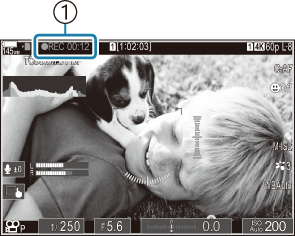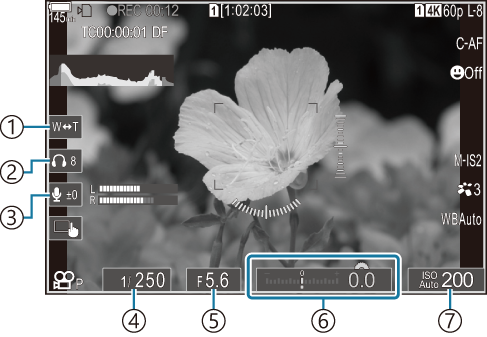Recording Movies
- When recording movies, use an SD card that supports an SD speed class of 10 or higher.
A UHS-II or UHS-I card with a UHS speed class of 3 or better is required when:
- a movie resolution of [4K] or [C4K] is selected in the [nX] menu or a Motion Compensation of [A-I] (All-Intra) is selected in the [nX] menu
- When the camera is used continuously for extended periods, the temperature of the image sensor will rise and noise and color splotches may be visible in the display. Should this occur, turn the camera off and wait for it to cool. Noise and color splotches are particularly likely to occur at high ISO sensitivities. If the temperature of the sensor increases further, the camera will turn off automatically.
- When using a Four Thirds system lens, AF will not be available during movie recording.
- When high-speed movie recording is selected for [nX], movies shot with [i-Enhance] or an art filter selected for picture mode will be recorded in [Natural] mode.
- The sound of touch operations and button operations may be recorded.
- CMOS image sensors of the type used in the camera generate a so-called “rolling shutter” effect that can cause distortion in pictures of moving objects. This distortion is a phenomenon that occurs in pictures of fast-moving subjects or if the camera is moved during shooting. It is particularly noticeable in pictures taken at long focal lengths.
- When an SDXC card is used, movies up to 3 hours long can be recorded. Movies over 3 hours are recorded over multiple files (depending on shooting conditions, the camera may start recording to a new file before the 3-hour limit is reached).
- When an SD/SDHC card is used, movies over 4 GB in size are recorded over multiple files (depending on shooting conditions, the camera may start recording to a new file before the 4 GB limit is reached).
- Divided movie files can be played back as a single movie. g “Playing back separated movies”
- When shooting a movie with the camera in portrait position, the information is recorded in portrait position. When the movie is played back on a computer or smartphone, it will be played back in the same orientation that it was shot in.
Recording movies in movie mode (n)

Rotate the mode dial to n (movie mode) to record movies using the effects available in P, A, S, and M modes (“Choosing an Exposure Mode (nMode (Movie Exposure Modes))”).
Rotate the mode dial to n.

Press the R button to begin recording.
- A beep is not heard when the camera focuses in movie mode.
- Movie you are recording will be displayed on the monitor.
- If you put your eye to the viewfinder, movie you are recording will be displayed in the viewfinder.
- A red frame is displayed during movie recording (“Displaying a red frame while recording movies (Red Frame during RREC)”).
- You can change the focus location by tapping the screen while recording.
- The camera will start the recording count and display the recording time.
- You can also begin recording movies by pressing the shutter button. g “Recording a movie by pressing the shutter button (nShutter Function)”
- Press the R button again to end recording.
Choosing an Exposure Mode (nMode (Movie Exposure Modes))

You can create movies that take advantage of the effects available in P, A, S, and M modes.
- Press the MENU button to view the menus.
- Highlight the n tab using the front dial.
- Highlight [1. Basic Settings/Image Quality] using the HI buttons or the rear dial.
- Highlight [nMode] using the FG buttons and press the OK button.
Highlight the desired mode using FG buttons and press the OK button.
P Optimal aperture is set automatically according to the brightness of the subject.
Use the front dial or rear dial to adjust exposure compensation.
A Depiction of background is changed by setting the aperture.
Use the front dial to adjust exposure compensation and rear dial to adjust aperture.
S Shutter speed affects how the subject appears. Use the front dial to adjust exposure compensation and rear dial to adjust shutter speed.
Shutter speed can be set to values between 1/24 s and 1/32000 s.
M Freely adjust both aperture and shutter speed.
Use the front dial to select aperture value and the rear dial to select shutter speed.
- Choose from shutter speeds of 1/24–32000 s. Values of ISO 200–12800 are available using the [nISO] manual sensitivity control options.
- The display shows the difference between the exposure produced by the selected aperture and shutter speed and the optimal exposure metered by the camera. The display will flash if the difference exceeds ±3 EV.
- The option chosen for [bISO-A Upper/Default] takes effect.
- The low end of the shutter speed changes according to the frame rate of the movie record mode.
- Press the MENU button to exit the menus.
- [nMode] can also be set from the super control panel. g “Setting with Super Control Panel/LV Super Control Panel”
Recording movies in photo shooting modes

Movies can be recorded in program AE mode even when the mode dial is not in the n position.
- [RREC] must be assigned to a button using [Button Function].
- The AF target takes on the shape selected for movie mode (“Recording movies in movie mode (n)”). Rotate the mode dial to n (movie mode) and choose target shape in the AF target selection display (“Choosing an AF Target Mode (AF Target Mode)”).
Press the button to which [RREC] has been assigned to begin recording.
- “NREC”, the recording time, and a red frame are displayed during movie recording (“Displaying a red frame while recording movies (Red Frame during RREC)”).

- Recording time
- If you put your eye to the viewfinder, movie you are recording will be displayed in the viewfinder.
- You can change the focus location by tapping the screen while recording.
Press the button again to end recording.
- When recording ends, “NREC”, the recording time, and the red frame are cleared from the display (“Displaying a red frame while recording movies (Red Frame during RREC)”).
Even if you press a button to which [RREC] has been assigned, you cannot record movies in the following instances:
- During a multiple exposure (still photography also ends), while the shutter button is pressed halfway, during sequential shooting, time-lapse photography, keystone compensation, or fish-eye correction, or while live ND shooting or live GND shooting are in use
Touch Controls (Silent Controls)

You can prevent the camera from recording operating sounds that occur due to camera operations while shooting. After tapping an item, tap the displayed arrows to select the settings.

- Electronic Zoom: Zoom power zoom lenses in or out.
- Headphone Volume: Adjust volume when using headphones.
- Sound Recording Level: Choose the recording level.
- Shutter Speed: Adjust shutter speed when [S] (shutter-priority AE) or [M] (manual) is selected for [nMode] (movie exposure mode) (“Choosing an Exposure Mode (nMode (Movie Exposure Modes))”).
- Aperture Value: Adjust aperture value when [A] (aperture-priority AE) or [M] (manual) is selected for [nMode] (movie exposure mode) (“Choosing an Exposure Mode (nMode (Movie Exposure Modes))”).
- Exposure Comp.: Adjust exposure compensation. If [M] is selected for [nMode] (movie exposure mode) (“Choosing an Exposure Mode (nMode (Movie Exposure Modes))”), exposure compensation is available when [Auto] is selected for [nISO].
- nISO: Adjust [nISO]. This option is available when [M] is selected for [nMode] (movie exposure mode) (“Choosing an Exposure Mode (nMode (Movie Exposure Modes))”).
- Silent controls are not available during high-speed movie recording (“Filming High-Speed Movies”).
- You can configure the camera so that silent controls using the touch panel can also be used during still photography. g [Silent 7 Operation]
